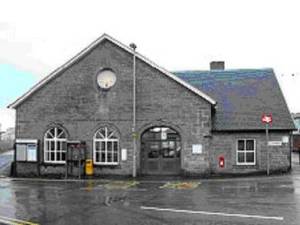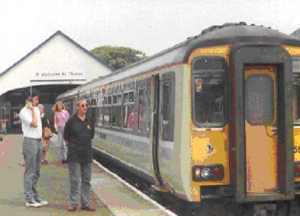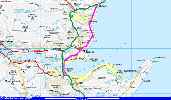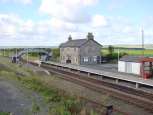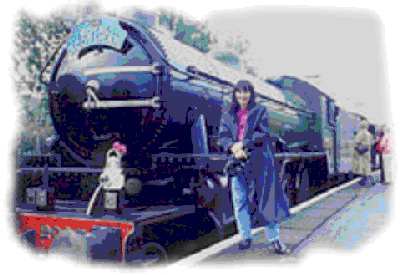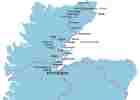 | Caithness.Org | Community | Business | Entertainment | Caithness... | Tourist Info | Site Map |
• Advertising • Chat Room • Contact Us • Kids Links • Links • Messageboard • News - Local & Scottish • News - UK & News Links • About / Contact Us • Submissions |
• Bookshop • Business Index & News • Jobs • Property For Sale • Property For Rent • Shop • Sutherland Business Index |
• Fishing • Fun Stuff • George, The Saga • Horses • Local Galas • Music • Pub Guide • Sport Index • What's On In Caithness |
• General Information • B & Bs • Backpackers • Caravan & Camping • Ferries • Getting Here • Holiday Letting • Hotels • Orkney • Pentland Firth • Sutherland • Taxis |
| N E W S F E E D S >>> |
A Better Railway for the North
Proposal
for a Strategic Assessment Study of the Far North Railway
Corus Railway Infrastructure Services
| 2.0 Introduction |
|
Corus is pleased to produce a proposal for a Strategic Assessment Study of the Far North Railway. This would be an innovative study looking at the opportunities for investment in infrastructure improvements to shorten the rail journey times and enhance the line�s capacity. The study would look at the tangible benefits for the people of Sutherland, Caithness and Orkney. The study would consider the whole route from Inverness to Wick and Thurso. The study would look at the market demand for rail services and how it could be supported in an enhanced timetable. A limited market survey could be done as part of the study.
A new railway link via Dornoch, to shorten the route, will be a major consideration. Corus will look at a different way of achieving this than the 1985 British Rail scheme. Corus has done a basic appraisal of the route to drive out the issues. This needs to be followed by a detailed engineering and environmental appraisal, which can examine the costs and feasibility. The new station at Dornoch should be closer to the centre of the town on the common ground. This would make it accessible by foot from the town and would remove all the level crossings proposed in the 1985 scheme. The railway could be on a new, faster alignment, allowing 90-100 mph running. The Corus alignment would be more acceptable to the environment and cheaper to construct. The Loch Fleet crossing could be simpler, cheaper and environmentally sympathetic. The many options for the Dornoch Firth crossing need to be examined. Corus can provide the in-depth expertise in railway bridge design to assess the current structure and provide the most cost effective solution for a combined road rail crossing.
Included in the study would be an assessment of providing a chord line at Georgemas Junction, with a new station at Halkirk to replace Georgemas Junction Station. This would better serve the settlement of Halkirk and also shorten the route.
The whole Far North Line would be appraised to see how and where speeds could be increased to 90 or 100 mph. This would address many of the journey time issues, including current train performance. The study would also look at the opportunities for continued use and development of the Lairg loop. There is an opportunity to provide a major tourist attraction with a steam railway in Easter Ross and Caithness with bases in Tain and Rogart. The journey along the Dornoch Firth, past the Falls of Shin and Ben Doula to Rogart is outstanding. Its scenic potential can be exploited to the full with steam train excursions.
Corus believes that there is a suppressed demand for rail travel on the line, which has not seen the growth other similar lines have achieved. Partly this is due to the physical route the line takes, compared with the competing A9 Trunk Road, but partly this is due to the nature of the rail services offered. This is borne out by a comparison with the Kyle of Lochalsh line, which has seen a substantial growth in rail usage, with a very low population base. The Far North Line with its much larger population base in Sutherland and Caithness has seen little growth there. Growth has been high, though, in the commuter services from Tain to Inverness, which can compete with the A9 Trunk Road. The Highlands and Islands Enterprise Board have made the case for rail improvements recently, in a report (The Case for Rail in the Highlands and Islands � Steer Davies Gleave - Final Report - March 2004). This report, based on passenger surveys has shown the economic benefits that the Far North Railway brings to the Highlands. The Highland Council Structure Plan 1999 (as modified) recognises that a Tain � Dornoch � Golspie rail link would achieve �� a considerable shortening of the journey time for rail passengers between Caithness / South East Sutherland and Inverness� and that the Council ��will have regard to the future possibility of construction of a direct rail link between Tain and Golspie in the consideration of relevant development proposals�. The infrastructure enhancements proposed will reduce the end to end mileage of the line. At the same time there is the opportunity to change the service pattern and offer a really competitive journey. Corus proposes to study how an end to end journey time of 2 hours from Inverness to Thurso could be achieved. Our proposal is for a fast service stopping at Inverness, Tain, Dornoch, Golspie, Brora, Helmsdale, Halkirk, Thurso and then Wick. This would run on a two hourly basis. The service would be timed as an extension of the Edinburgh to Inverness services, to offer a high quality service to the capital. This would be coupled with a regular, all stations service from Inverness to Tain and Lairg. The option of a stops at new station at Evanton and Conon Bridge would be explored. Together this new package of services would make a real difference to travellers, opening up new economic and employment opportunities. Thurso and Wick are the largest and most significant urban centres north of Inverness. The Caithness community suffers from the excessively slow journey times of 3� - 4 hours to the main Highland regional and market centre at Inverness. The new proposals would encourage rail usage and broaden travel opportunities for Caithness. Helmsdale, Brora, Golspie and Dornoch as the major Sutherland townships, would gain the social and economic benefit of a fast commuter rail service with arrival before 9 o�clock in Inverness (currently impossible by the inland Lairg line). Freight services, too, would benefit from a shorter transit time. The journey times from Georgemas to Mossend now do not allow enough terminal time at Mossend Intermodal Freight Terminal for unloading and reloading of the same wagons, causing additional resources to be employed on these flows. The saving of over an hour on the combined out and back transit times could improve the economics of these services, compared to road haulage. Both for freight and for passenger services, the faster transit times will produce far better utilisation of rolling stock, locomotives and train crew. For passenger trains (and train crews) a 50 � 75% improvement in utilisation may be possible, in itself funding a major part of the proposed improvements. The increased service level, will in itself, improve the revenue yield, creating a virtuous circle of rising yields and falling costs per mile. The review
of proposals for the Tain � Golspie Link and the Georgemas Chord would
include: In
particular the following ideas would be commented on: The Corus proposal is for a detailed study, looking at the propensity to travel in Sutherland, Caithness and Orkney and how this could this could be turned into a marketable train service to meet that need. The study would provide a definitive answer on the need, advantages and cost of a new Tain � Golspie Rail Link and other infrastructure improvements. This would be delivered by market research, infrastructure and timetable modelling and by engineering and environmental assessments. The study would look at how the five objectives of the Scottish Transport Appraisal Guidance (STAG), environment, safety, economy, integration and accessibility could be met. The STAG process is divided into two main parts. The Part One appraisal would allow the ready elimination of options, to produce a preferred option. The options would range from do nothing, ie, the Base Model in the modelling scenarios, to a series of Case Studies. The preferred option would be tested against other recently approved Scottish projects to establish value for money. However the test of social inclusion would also be applied to a project in the Highlands. The Part Two evaluation, would be a detailed examination of how the preferred option best meets the five objectives. This would not be part of this study. The study would however show how the preferred option, if proven, could be progressed through the STAG Part Two evaluation and brought to Parliamentary Bill standard.
|
|||
| Forward To Background | |||



